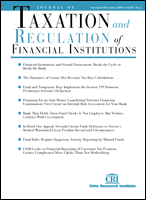Complete Issue
Author: Houman B. Shadab.
Source: Volume 29, Number 02, November/December 2015 , pp.1-48(48)

< previous article |return to table of contents
Abstract:
Our first article, by Alan I. Appel and Jessica J. Edwards, provides an overview of tax issues in credit agreements that all lenders should be aware of. The authors discuss concerns such as the allocation of taxes on payments, withholding documentation requirements, and tax representations and covenants. As the authors note, how tax costs and risks are allocated between lenders and borrowers can have a significant impact on a loan’s expected return, as well as its security. Caren D. Enloe, in our second article, analyzes the Sixth Circuit’s decision in Anarion Investments LLC v. Carrington Mortgage Services, LLC, which for the first time held that artificial persons have standing to sue under the Fair Debt Collection Practices Act. The decision seems to contradict the Act’s purpose and express limitation to natural persons, and thereby gives a new class of plaintiffs the opportunity to claim protections under the Act. Loan agreements often increase the rate of interest that applies when a debtor goes into default. In our third article, Steven Wilamowsky and Laura E. Appleby discuss the circumstances under which a secured lender can earn the default rate of interest while the debtor is in bankruptcy. The authors note that a secured creditor typically is entitled to default interest even when the debtor is in bankruptcy, so long as the claim for default interest is made before the debtor files for bankruptcy. However, the court may nonetheless agree to a lower, non-default rate pursuant to a judicial cramdown. In addition, as the authors highlight in their discussion of the Eleventh Circuit’s recent Sagamore Partners decision, a debtor may also reinstate the non-default rate of interest by satisfying any default interest requirements. Reform of the derivatives markets has been among the more contested areas of rulemaking under the Dodd-Frank Act. In our fourth article, Keila Espinosa discusses the ongoing and incomplete Commodity Futures Trading Commission (CFTC) rulemaking surrounding position limits for certain commodity futures and economically equivalent swaps. As Ms. Espinosa notes, the original rules were promulgated in 2011 only to be vacated by a judicial challenge in 2012. In 2013, the position limits rules were re-proposed, along with proposals regarding related position aggregation rules, the most recent of which was made on September 22, 2015. Based on what seem to be fundamental concerns about the re-proposed rules’ authority and compliance with administrative requirements, it is unclear when the CFTC’s position limits rules will be finalized and whether they will be able to survive another judicial challenge. This issue concludes with a Banking Developments column highlighting aspects of comments filed in response to the Treasury Department’s July 15, 2015, request for information about online marketplace lending. Treasury received 107 responses about the growing, approximately $12 billion, industry that it defines as that “segment of the financial services industry that uses investment capital and data-driven online platforms to lend to small businesses and consumers.” The column focuses on commentators’ statements relating to small business loan markets; the nature, benefits, and potential detriments of marketplace lending; and regulatory issues.Keywords: Credit agreement; Fair Debt Collection Practices Act; default-rate interest; bankruptcy; position limits; ISDA/SIFMA comment; online lending platforms
Affiliations:
1: New York Law School.